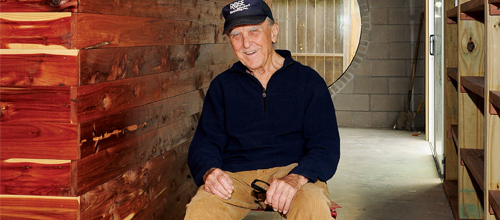Urban Architect Rooted in Nature
John Zemanek keeps it natural with his new energy-efficient home
Photos by Dalton DeHart
Architect and University of Houston associate professor John Zemanek is building a new home in the neighborhood he’s lived in for over 50 years. He’s downsizing from his landmark Montrose home on the corner of Van Buren and Peden. The design of the new home, just one block south on Van Buren, is distinctively Zemanek, with some state-of-the-art energy-efficient features.
The six-inch thick roof deck is made of Tekton, a cement and recycled wood product designed for superior insulation. Very large solar panels spanning the front of the structure provide approximately 70 percent of the home’s electricity. While more restricted neighborhoods or a more traditional style might dictate the panels be hidden or disguised, they are front and center in Zemanek’s new home. Along with cedar, concrete, and large expanses of glass, the solar panels work beautifully with this contemporary design. Zemanek has been careful to preserve two large cedar trees growing on the property, and he also used fragrant, locally harvested cedar planks in the interior. “One thing leads to another,” the architect remarks. He, like Frank Lloyd Wright, espouses organic architecture.

He shows off a small stand of Texas wildflowers growing in his front yard. A self-described country boy, Zemanek attributes his love of nature to growing up on a farm. And it’s this intimacy with nature that he says makes conservation and energy efficiency important to him. He hopes to have his new home LEED certified. Commenting on the wasteful habits of today’s typical consumer, he says that “we’re burning the candle at both ends and we don’t have to. It’s a matter of association. Does burning the candle at both ends [produce] a more complete life, or does coexistence with nature make a life more complete?” He explains with a measure of frustration that “it just doesn’t register with some people. They drive through acres and acres of wildflowers and they’re playing with their digital toys,” says Zemanek, who doesn’t use a cellular phone.
Although he’s lived in Montrose since the 1950s, he points out that the neighborhood hasn’t really changed dramatically compared to Houston outside the loop. He remembers when there were cotton fields around the Galleria. He does think the city’s new historic ordinance is very important for neighborhoods like Montrose. He explains that his new house sits on a lot measuring less than 5,000 square feet that had been slated for three townhouse units before he bought the vacant lot for his single-family home from a builder. His other reason for supporting ordinances restricting the demolition of historic homes is simple: “I have yet to see a new building that is better for the neighborhood than what was there.” He laughs and adds that he excludes his own project, of course.
And what has it been like for Zemanek to live in the epicenter of Houston’s gay community for five decades? “It seems to be so naturally integrated. Again using that word nature—it seems like it’s always been like this and it’s not stressful or conspicuous. There’s an ‘if the shoe fits, wear it’ spirit. It’s very nice,” he says.
John Zemanek predicts that when the residential building market heats up again, the trend will be toward downsizing, conservation, and energy efficiency.
Karen Derr is a frequent contributor to OutSmart magazine.











Comments